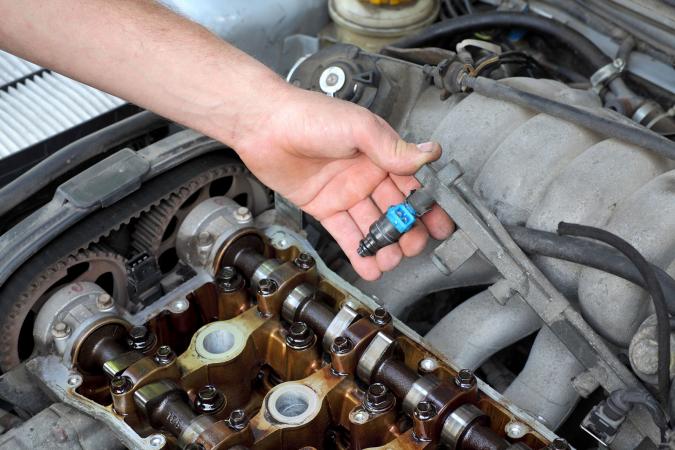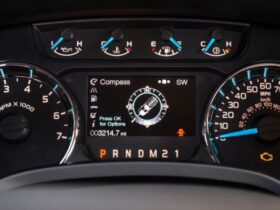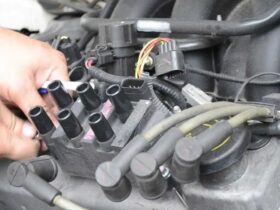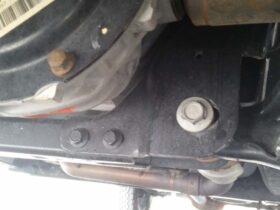Maintaining clean fuel injectors is crucial for your Ford F-150‘s performance, efficiency, and longevity. This comprehensive guide will walk you through cleaning your truck’s fuel injectors safely and effectively.
Why Clean Your Fuel Injectors?
Before diving into the cleaning process, it’s important to understand why fuel injector maintenance is essential:
- Ensures optimal fuel delivery and spray pattern
- Improves engine performance and fuel economy
- Reduces emissions and environmental impact
- Prevents expensive repairs and injector replacement
- Maintains smooth engine operation
- Extends injector lifespan
Safety Precautions
Before starting the cleaning process, ensure you have the following safety equipment:
- Safety Glasses: Protect your eyes from chemicals and debris
- Rubber Gloves: Chemical-resistant gloves to protect your skin
- Well-Ventilated Area: Work in an open or well-ventilated space
- Fire Extinguisher: Keep one nearby as you’re working with fuel systems
- Shop Towels: For cleaning spills and wiping components
Required Tools and Materials
- Fuel injector cleaning kit (Professional grade)
- Socket set and wrenches
- Screwdrivers (flathead and Phillips)
- Fuel pressure gauge
- Owner’s manual
- Clean shop rags
- Compressed air
- Fuel injector cleaner solution
Understanding Fuel Injector Cleaners
Types of Fuel Injector Cleaners
1. Polyether Amine (PEA)
- The most effective cleaning agent
- Removes tough carbon deposits
- Recommended for severe contamination
- Higher cost but better results
2. Polyisobutylene (PIB)
- Suitable for diesel engines
- Prevents deposit formation
- Good for maintenance cleaning
3. Polyisobutylene Amine (PIBA)
- Works with moisture
- Acts as a detergent
- Helps prevent misfiring
- Good for regular maintenance
Step-by-Step Cleaning Process
1. Locating the Fuel Injectors
- Open your F-150’s hood and secure it properly
- Consult your owner’s manual for the exact injector location
- Different engine configurations will have different layouts:
- 3.5L EcoBoost: Injectors are mounted in the intake manifold
- 5.0L V8: Injectors are visible on top of the engine
- 2.7L EcoBoost: Requires removal of engine cover
2. Preparing the System
- Relieve fuel system pressure
- Remove the fuel pump fuse
- Start the engine and let it stall
- Crank engine for 5 seconds to release the remaining pressure
2. Disconnect the battery
- Remove the negative terminal first
- Wait 15 minutes before proceeding
3. Cleaning Process
- Remove Boost Controller Vacuum Line (if equipped)
- Mark the connection points
- Carefully disconnect the line
- Store safely for reinstallation
- Disconnect Fuel System Components
- Locate fuel rail
- Disconnect the fuel supply line
- Place drain pan under connections
- Use compressed air to clean connections
- Connect Cleaning Kit
- Attach the appropriate adapter to the fuel rail
- Connect cleaner canister
- Ensure all connections are tight
- Fill with approved cleaning solution
- Perform Cleaning
- Start engine if kit requires
- Allow the cleaner to circulate (typically 15-20 minutes)
- Monitor pressure gauge
- Listen for unusual sounds
- System Restoration
- Reconnect fuel lines
- Reinstall vacuum lines
- Reconnect electrical connections
- Reinstall fuel pump fuse
Signs of Clogged Fuel Injectors
Watch for these symptoms indicating cleaning is needed:
1. Performance Issues
- Rough idle
- Poor acceleration
- Engine misfires
- Decreased power
2. Fuel Economy Problems
- Increased fuel consumption
- Inconsistent fuel economy
- Poor gas mileage
3. Starting and Running Issues
- Hard starting
- Rough running
- Hesitation under load
- Stalling
4. Other Indicators
- Check Engine light
- Failed emissions test
- The engine knock or ping
- Black exhaust smoke
Maintenance Tips
Preventive Maintenance Strategies
Maintaining your Ford F-150’s fuel system requires a proactive approach beyond basic maintenance. The foundation of effective preventive maintenance starts with fuel quality. Always choose high-quality fuel from reputable stations that maintain storage tanks and regularly test for contamination. Premium fuel stations often include detergent additives that help keep injectors clean and prevent carbon buildup over time.
Adding a quality fuel injector cleaner every 10,000 miles is crucial for maintaining optimal fuel system performance. When selecting a fuel injector cleaner, look for products containing PEA (Polyether Amine) as the active ingredient, as this chemical is most effective at removing deposits. The best practice is to add the cleaner when your tank is nearly empty, then fill it up with fuel to ensure proper mixing and distribution throughout the system.
The fuel filter plays a critical role in protecting your injectors from contamination. Following Ford’s recommended replacement schedule for the fuel filter – typically every 30,000 to 50,000 miles – helps prevent debris from reaching the injectors. A clogged fuel filter can restrict fuel flow, causing poor performance and potentially damaging the pump.
One often overlooked aspect of fuel system maintenance is maintaining proper fuel levels. Keeping your tank above quarter-full isn’t just about avoiding running out of fuel – it also helps keep the fuel pump cooled and lubricated, as the fuel in the tank acts as both coolant and lubricant for the pump. Additionally, a fuller tank reduces condensation formation, which can lead to water contamination in your fuel system.
Regular Inspection Protocol
A regular inspection routine is essential for catching potential issues before they become serious problems. Start by paying attention to engine sounds during operation. Any unusual noises, particularly ticking or clicking sounds when accelerating, could indicate fuel injector problems. A properly functioning engine should run smoothly without irregular sounds or vibrations.
Monitoring fuel economy is one of the most effective ways to track fuel system health. Keep a log of your mileage and fuel consumption – many modern F-150s have built-in fuel economy tracking systems. A sudden drop in fuel economy (more than 10-15%) often indicates fuel system issues that need attention. Consider using a fuel tracking app or spreadsheet to maintain accurate records and spot trends.
Regular visual inspections for fuel leaks are crucial. Check underneath your truck for any signs of fuel drips or puddles, particularly after parking overnight. Inspect fuel lines and connections for any signs of wetness, staining, or corrosion. Pay special attention to connection points and areas where fuel lines pass near hot engine components.
Engine performance observation should be part of your daily driving routine. Note how the engine responds to acceleration, whether it maintains steady idle, and if there’s any hesitation or stumbling when accelerating. Modern F-150s have sophisticated engine management systems that can compensate for minor fuel system issues, but paying attention to subtle changes in performance can help identify problems early.
Professional Service vs. DIY Maintenance: Making the Right Choice
DIY Advantages
Choosing to maintain your F-150’s fuel system yourself offers several significant benefits. The most obvious is cost savings – professional fuel system service can cost anywhere from $200 to $500, while DIY cleaning typically costs $30-100 in materials. Beyond immediate financial benefits, performing your maintenance provides valuable hands-on experience with your vehicle’s fuel system, helping you better understand how it works and what to look for when problems arise.
DIY maintenance also offers unprecedented convenience – you can perform services on your schedule, often in the evenings or on weekends when professional shops are closed. This flexibility allows you to maintain a regular maintenance schedule without disrupting your work or family commitments. Additionally, doing your maintenance enables you to establish a consistent routine, ensuring that preventive care happens at optimal intervals rather than waiting for appointment availability at a service center.
Professional Service Benefits
While more expensive, professional service offers distinct advantages that may outweigh the cost for many F-150 owners. Professional shops can access specialized diagnostic equipment and cleaning tools that aren’t practical for individual owners to purchase. This equipment can provide a more thorough cleaning and more accurate diagnosis of fuel system issues.
Professional technicians bring extensive experience and training to their work. They can often identify related issues that might be missed during DIY maintenance and understand the complex interactions between different vehicle systems. This expertise is particularly valuable when dealing with modern F-150s, which feature sophisticated electronic fuel injection systems and complex engine management computers.
Perhaps most importantly, professional service typically comes with warranty coverage for parts and labor. If something goes wrong during or after the service, you’re protected. Additionally, having documented professional service can help maintain your vehicle’s warranty coverage and provide valuable service history documentation when it’s time to sell your truck.
The time savings offered by professional services can be significant. What might take an experienced mechanic an hour or two could take a DIY enthusiast an entire weekend, especially when accounting for the time needed to purchase supplies, prepare the work area, and clean up afterward. This time saving can justify the additional cost of professional service for busy professionals or those less comfortable with automotive work.
Remember, these approaches aren’t mutually exclusive – many F-150 owners combine DIY maintenance for routine tasks with professional service for more complex issues or periodic deep cleaning. The key is finding the right balance based on your skills, time, and comfort level with automotive maintenance.
Additional Resources
- Ford Owner’s Manual
- Ford Technical Service Bulletins
- ASE Certified Mechanics Directory
Note: Always consult your vehicle’s specific manual and warranty information before performing any maintenance. Improper cleaning procedures can damage fuel injectors and void warranties.






Leave a Reply
View Comments